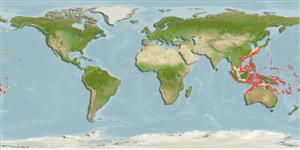>
Eupercaria/misc (Various families in series Eupercaria) >
Lutjanidae (Snappers) > Etelinae
Etymology: Pristipomoides: Greek, pristis = saw + Greek, poma, -atos = cover, operculum + Greek, oides = similar to (Ref. 45335).
More on author: Valenciennes.
Environment: milieu / climate zone / depth range / distribution range
Écologie
marin récifal; profondeur 70 - 350 m (Ref. 9821). Tropical; 35°N - 24°S, 98°E - 167°W (Ref. 55)
Indo-Pacific: East Africa to the Society Islands, north to southern Japan, south to New Caledonia.
Taille / Poids / Âge
Maturity: Lm ? range ? - ? cm
Max length : 40.0 cm SL mâle / non sexé; (Ref. 9821); common length : 25.0 cm SL mâle / non sexé; (Ref. 9821)
Épines dorsales (Total) : 10; Rayons mous dorsaux (Total) : 11; Épines anales: 3; Rayons mous anaux: 8. Interorbital space slightly convex. Preorbital depth 7.0 to 8.0 times in head length. Pectoral fins long, reaching level of anus. Scale rows on back parallel to lateral line. The upper part of the head reddish; the back mainly yellow; the sides and belly silvery, sometimes pinkish; body with very many bright blue spots and vermiculations. The dorsal and caudal fins yellowish.
Adults are found over rocky bottoms. They feed on small fishes, crustaceans and squids.
Life cycle and mating behavior
Maturities | Reproduction | Spawnings | Egg(s) | Fecundities | Larves
Allen, G.R., 1985. FAO Species Catalogue. Vol. 6. Snappers of the world. An annotated and illustrated catalogue of lutjanid species known to date. FAO Fish. Synop. 125(6):208 p. Rome: FAO. (Ref. 55)
Statut dans la liste rouge de l'IUCN (Ref. 130435)
Menace pour l'homme
Harmless
Utilisations par l'homme
Pêcheries: intérêt commercial mineur
Outils
Articles particuliers
Télécharger en XML
Sources Internet
Estimates based on models
Preferred temperature (Ref.
123201): 15.2 - 26.2, mean 20.4 °C (based on 252 cells).
Phylogenetic diversity index (Ref.
82804): PD
50 = 0.5005 [Uniqueness, from 0.5 = low to 2.0 = high].
Bayesian length-weight: a=0.01514 (0.00893 - 0.02566), b=3.00 (2.86 - 3.14), in cm total length, based on LWR estimates for this species & Genus-body shape (Ref.
93245).
Niveau trophique (Ref.
69278): 4.2 ±0.57 se; based on food items.
Résilience (Ref.
120179): Milieu, temps minimum de doublement de population : 1,4 à 4,4 années (Preliminary K or Fecundity.).
Fishing Vulnerability (Ref.
59153): Moderate vulnerability (39 of 100).
Nutrients (Ref.
124155): Calcium = 40.7 [22.0, 71.5] mg/100g; Iron = 0.638 [0.331, 1.057] mg/100g; Protein = 18.9 [17.0, 20.7] %; Omega3 = 0.184 [0.114, 0.294] g/100g; Selenium = 46.9 [27.3, 85.5] μg/100g; VitaminA = 116 [42, 380] μg/100g; Zinc = 0.863 [0.599, 1.221] mg/100g (wet weight);
